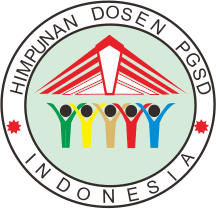Pengaruh model pembelajaran student teams achievement divisions berbantuan game pada aplikasi wordwall terhadap hasil belajar matematika materi bilangan cacah ditinjau dari motivasi belajar
Abstract
Keywords
References
F. Susanto, “Meta Analisi Pengaruh Model Pembelajaran Numbered Head Together Terhadap Hasil Belajar Matematika Siswa Kelas V SD,” Mahaguru: Jurnal Pendidikan Guru Sekolah Dasar, 2(1), 2021. [2] A. Solihah, “Pengaruh Model Pembelajaran Teams Games Tournament (TGT) terhadap Hasil Belajar Matematika,” SAP (Susunan Artikel Pendidikan), 1(1), 2016. [3] Pusat Penilaian Pendidikan Balitbang Kemendikbud, “Pendidikan di Indonesia Belajar dari Hasil PISA 2018,” Pusat Penilaian Pendidikan Balitbang Kemendikbud, 021, 2019. [4] I. Amaliya dan I. Fathurohman, “Analisis Kemampuan Literasi Matematika Ditinjau dari Gaya Belajar Siswa SDN Mangunjiwan 1 Demak,” JRPD (Jurnal Riset Pendidikan Dasar), 5(1), 2022. [5] S. Bukit, E. D. Marcela, dan E. Ernawati, “Teacher’s Strategy to Create Fun Learning in Elementary School,” Journal Corner of Education, Linguistics, and Literature, 2(3), 2023. [6] U. Sudrajat, “Model pembelajaran student teams achievement divisions (STAD) untuk meningkatkan aktivitas dan hasil belajar PKn di kelas IV sekolah dasar,” Jurnal Pendidikan Dasar, 10(1), 2022. [7] A. Suprijono, “Cooperatif Learning,” Pustaka Pelajar, 1(1), 2013. [8] E. Ambarningrum, S. St Y, dan K. Karsono, “Pengaruh model pembelajaran student team achievment divisions (STAD) dan motivasi belajar terhadap kemampuan menulis puisi pada siswa kelas V sekolah dasar,” JPI (Jurnal Pendidikan Indonesia): Jurnal Ilmiah Pendidikan, 7(4), 2020. [9] M. B. Aji, S. Sukarno, dan K. Kartono, “Penerapan model pembelajaran kooperatif tipe stad dipadukan dengan snowball throwing untuk meningkatkan keterampilan sosial,” Didaktika Dwija Indria, 7(1), hlm. 68–73. [10] V. D. Tran, “Does cooperative learning increase students’ motivation in learning?,” International Journal of Higher Education, 8(5), 2019. [11] D. Safitri dkk., “Improvement of Student Learning Motivation through Word-Wall-based Digital Game Media,” International Journal of Interactive Mobile Technologies, 16(6), 2022. [12] H. Rukiah, S. Dasar, N. H. Tabalong, dan K. Selatan, “Meningkatkan Kemampuan Operasi Hitung Siswa pada Pembelajaran Matematika dengan Menggunakan Permainan Kartu di Kelas II SDN Habau Tahun Pelajaran 2016/2017,” Jurnal Penelitian Tindakan dan Pendidikan, 4(2), 2018. [13] L. Lomu dan S. A. Widodo, “Pengaruh Motivasi Belajar dan Disiplin Belajar terhadap Prestasi Belajar Matematika Siswa,” Prosiding Seminar Nasional Pendidikan Matematika Etnomatnesia, 2018. [14] M. A. Nisa dan R. Susanto, “Pengaruh Penggunaan Game Edukasi Berbasis Wordwall Dalam Pembelajaran Matematika Terhadap Motivasi Belajar,” JPGI (Jurnal Penelitian Guru Indonesia), 7(1), 2022. [15] R. Rusmiati Aliyyah, Rasmitadila, R. Rachmadtullah, Widyasari, D. Mulyadi, dan S. Ikhwan, “Using of student teams achievement divisions model (STAD) to improve student’s mathematical learning outcomes,” dalam Journal of Physics: Conference Series, 1175, 2019. [16] F. Nur Syamsu, I. Rahmawati, dan S. Suyitno, “Keefektifan Model Pembelajaran STAD terhadap Hasil Belajar Matematika Materi Bangun Ruang,” International Journal of Elementary Education, 3(3), 2019. [17] N. Soeryaningsih, B. Gaspar, dan S. Isman, “Pengaruh Animasi Interaktif dengan Model Explicit Instruction terhadap Prestasi Matematika,” GAUSS: Jurnal Pendidikan Matematika, 4(2), 2021. [18] T. L. Hsieh, “Motivation matters? The relationship among different types of learning motivation, engagement behaviors and learning outcomes of undergraduate students in Taiwan,” High Educ (Dordr), 68(3), 2014.
Refbacks
- There are currently no refbacks.



